At Furcadia’s September town meeting, a hundred humanoid animals lounged on purple pillows in a lush, 32-bit meadow. Emerald Flame, Executive Producer of the oldest social MMORPG, was explaining Furcadia’s largest update since its 1996 founding to the motley pile of furry avatars, known in-game as “furres.” It was called the “Second Dreaming.”
“We do have to modernise,” Emerald Flame said. “If we don’t modernise, we cannot survive as a game. That’s just the way it is.” In Furcadia, though, “modern” is a controversial thing.
Leading up to and following the “Second Dreaming’s” August rollout, Furcadia residents have been trickling out of the MMO. It is the titanic virtual worlds World of Warcraft and Final Fantasy XIV that set the tone for MMOs in 2016, and expectations calibrated to these giants have made change in Furcadia, free-to-play, a hard thing to digest.
Through fundraising, Dragon’s Eye Productions raised over $US250,000 ($325,185) to develop “The Second Dreaming,” Furcadia’s first true overhaul. For two decades, Furcadia was rendered with 8-bit graphics. Residents logged in with plaintext passwords and insecure INI files. Furres were attached to computers, not accounts, so upgrading hardware could be the death of a ten-year-old avatar.
For the “Second Dreaming,” over a dozen Furcadia volunteers labored nearly four years, cobbling together together taken-for-granted features of modern MMOS: email-linked accounts, safer log-in protocols as well as a less modern 32-bit graphics editor for user-generated content. “The Second Dreaming” has been long overdue, Furcadians believed, especially four years after the first round of fundraising.
Most loved it. But some furres thought the scope of the changes didn’t justify the time and price tag, while others were put off by even simple alterations to Furcadia’s archaic UI.
Furcadia is its own cyberspace terrarium, a vestige of early virtual worlds and all their virtues. It’s a vintage dream, crystallised by its community, from when players and developers were of the same caste and user-generated content was the very fabric of online gaming. That DIY ethos has preserved Furcadia for two decades; but has also stagnated it — an accusation waged by frustrated Furcadians exposed to modern MMORPGs.
In 2008, Furcadia’s user count peaked at around 75,000 users, representatives say; in 2016, the furry MMO still attracts about 15,000 “furres” whose time in-game is dominated by text-based role-play. Basic furre animations are limited to walking, sitting, lying down and using items — but Furcadians can breathe context into the most subtle motions.
On a chat client much like AOL Instant Messenger, furres describe imaginary actions their role-playing characters take. Humanoid animals are, at one time, geishas entertaining clients in a mountain onsen, or at another, darkly sadistic sex fiends hunting for wolfish pleasures. What users want from Furcadia is dictated in their descriptions, which sometimes link to Deviantarts loaded with detailed fan-fictions.
User-created content is the lifeblood of Furcadia, manifested as “dreams,” Furcadia’s name for handmade, self-contained zones where furres role-play. The people who make them are “dreamweavers.” Pokemon role-playing dreams, Middle-Eastern desert dreams, hazy purple space dreams, murder mystery hotel dreams and sprawling, sexy beach dreams are all open-access, carved out from meticulous 8-bit (or 32-bit, now) pixel art. Hub maps host these dreams, appearing as innocuous signs or portals.
Furres — and, here and there, a human — populate them, a facet of Furcadia that creator Dr. Cat says was never a bid for furry fandom: “We love animal characters,” Dr. Cat told me, referencing Sonic or Bugs Bunny. But, of course, the most popular dreams on Furcadia are 18+.
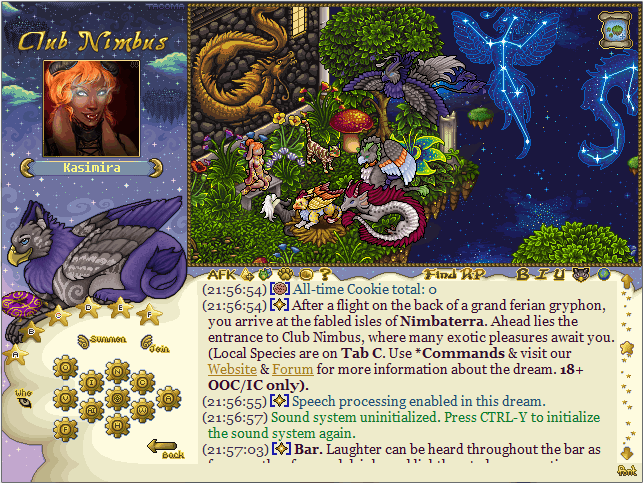
Furcadia. Credit: Kasimira
Lisa Frank would envy Furcadia’s avatars. Cotton-candy manes and prismatic dragon wings trim the same Furcadia resident, a hybrid horse-dragon, or something less discernable. “If we’d gone more generic, maybe we would have gotten bigger,” Dr. Cat explained, referring to the popularity of the Sims or Second Life. “A lot of the general public doesn’t want wizards or space ships.
They want real life — well, real life, except they have millions of dollars; the fantasy they can imagine living out if they won the lottery. Living in a spaceship or being a talking cat isn’t something you can buy with lottery money.”
A 34-year games industry veteran, Dr. Cat cut his teeth on Ultima before he and his game-making partner ‘Manda went on to design Dragon Spires. “We both had spent years doing hack-and-slash dungeon crawls, knights with swords. It was boring to us,” Dr. Cat said.
From a gameplay perspective, when combat was a possibility, it dominated communication. Role-playing in online games with combat was eclipsed by requests for clerics or tanks to round out a party. Hoping to solve the problem of emotional engagement, Dr. Cat thought back to the role-playing cultures on text-based multi-user-dungeons (MUDs) like LambdaMOO. The vital thing, he thought, was user-created content.
The panda furre Juliet and I sat cross-legged on wide, floating purple flowers that ushered us down a river. Trees, rendered in impeccable 32-bit pixel art, lined the shore. Juliet, 25, is a welcomer to Furcadia, and was giving me a tour of the MMO’s sights, some of which were a decade old. She estimates that she greets 20 new players a day, despite the drop-off in Furcadia’s player base over the last few years.
“As a dream artist myself, I really enjoy visiting dreams like this,” Juliet said of our surroundings. We were swept under a bridge. The animation propelling us forward was cut up like a glitched-out gif, but it was hard to concentrate on anything other than the rainbow greeting us at the end of the river.
The dream was a sleek facet of the latest update, far beyond what a capped 256 colours could render. Teleporting out, we entered a deep pool framed by a mural. A lion’s mouth spewed water, and behind us, a hill of flowers tumbled into the ocean.
In the pool, we met Furcadia’s Art Director, a grayish-purple fox with five tails. Majas, 26, was searching for an online version of Giga Pets when she stumbled upon Furcadia in middle school. She’s been on the game for 15 years, filling a variety of volunteer roles before spearheading art updates for “The Second Dreaming.”
“It’s like a home on the internet,” Majas explained. In 2008, Majas became a volunteer artist, and, after years sharpening her pixel artistry, eventually emerged as one of Furcadia’s go-to commissioners.
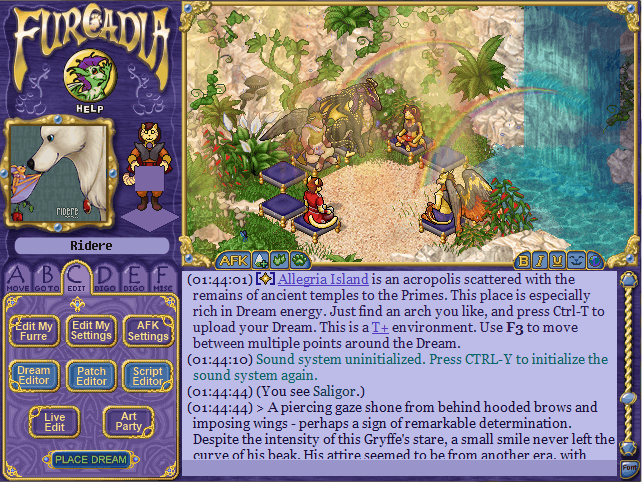
Furcadia. Credit: Ridere.
Majas helped design the “The Second Dreaming’s” 32-bit client, and then redesign it because it was too laggy. She likens working on Furcadia to being a 2016 indie developer running a game designed in the ’90s. Only about four members of Furcadia’s team are paid (Dr. Cat says he hasn’t taken money since 2009).
The rest are paid on and off from money pooled from premium content purchases, like fancy avatars.
“Not only do we have to make new stuff — we’re also keeping the old game running,” Majas explained. Majas has another job, and before that, went to school full-time. Her enormous contributions to Furcadia don’t go unnoticed by the community — she is publicly celebrated by Furcadians throughout online forums and dreams.
In fact, “The Second Dreaming’s” 32-bit update and image-making client are perhaps the most popular part of the update (a phoenix I met named Different Turret proudly showed off the rainbow sheen of his 32-bit avatar).
Other parts, like the UI change, have proven less popular. In modern MMOs, online character editing would be unheard of. Aspects of the game that lived, well, in-game migrated over to the internet. Character editing was in-game until recently, when it became web-based. A few longtime players had gripes with the switch.
“For altering colours and descriptors,” a Furcadia resident told me over email, “I think it is a waste of time having to [open the client] in a web browser rather than the old in-game methodology. And that ultimately saving information for character descriptions and colour is a huge pain in the arse.” On the other hand, the new web-based editor is much more sophisticated, albeit detached from the actual game. It’s separate, I hear, because it will tie into Furcadia’s upcoming mobile client, the status of which is unknown.
Additionally, dreams and graphics soon will increase in size as Furcadia’s dimensions expand: Currently, Furcadia lives in a client about a quarter the size of a desktop screen. Full-screen for MMORPGs is standard now, and a client as tiny as Furcadia’s is difficult to believe until you see it. In the updating process, furres fear that their pixel machinations will blur or dissolve. Hearing concerns about stretched art, however, the Furcadia staff is compensating by redrawing several properties in the game.
On Reddit last year, “The Second Dreaming” was rumoured to launch Summer, 2015. It was about three years after Furcadia’s successful Kickstarter, which raised $US170,000 ($221,125), and shortly after their second fundraising push, which added another $US80,000 ($104,059). A couple new avatars had been released promptly after Furcadia’s funding goals were met, along with a new map, some items and a test client for the 32-bit update.
However, residents were concerned that, years after the funding flood, the game was still stuck in the ’90s. Furcadians wondered where their money had gone. Many were concerned that the community, Furcadia’s greatest asset, would continue leaking out into other virtual worlds if innovation didn’t persist.
They wanted a 2016 MMO on a AAA timeline, or at least what they felt was their money’s worth, a never-before-waged criticism against the free game.
Given the absence of a sizable, professional full-time staff, “The Second Dreaming’s” jagged rollout is justified — but, in 2016, how can developers of a 15,000-strong virtual world be so irreverent of today’s expectations?
A near-idolization of user-generated online content is something specific to Furcadia, as well as circa-2000s social virtual worlds like Second Life and The Sims Online, and the reason why its developers are level with players. It’s what binds Furcadia’s community. As a result, the onus to make a better game is on players’ backs, and the onus to accommodate them is on Furcadia’s scrappy team of devs. “We have had people talk about ‘wanting to come visit the Dragon’s Eye office someday,’” Dr. Cat told me, “not realising that’s better known as ‘my house.’”
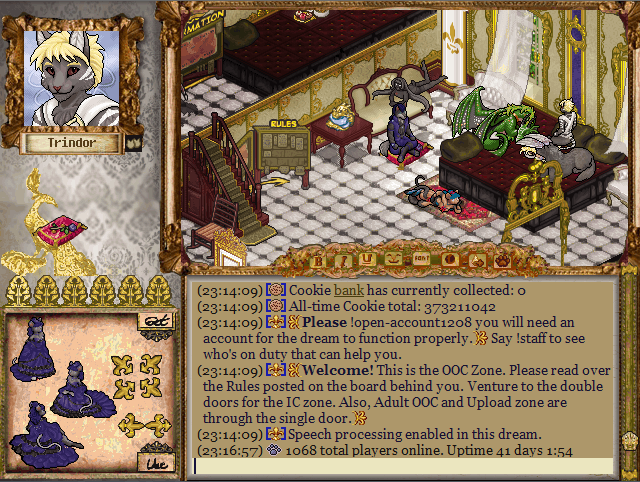
Furcadia. Credit: Trindor
For Furcadia, Dr. Cat developed a custom scripting language called DragonSpeak. It’s easily readable; the scripts are variations of cause-and-effect commands, sort of half-sentences. Furcadia residents all affirm that even a 12-year-old can master the scripting language — many of them were that age when they started cutting out their virtual dreams. Players piece together these dreams with DragonSpeak and 8 or 32-bit pixel art, which they use to animate shop keeps with voice lines or render a full Five Nights at Freddy’s mod complete with gaming elements.
User-generation, a principle of Furcadian life and a facet of its scrappiness, also applies to its developers: Majas and several other “Second Dreaming” shepherds learned graphics design or programming through the MMO itself. And what skills they gained from Furcadia, they invested back in — a speciality that few AAA MMORPGs can boast. Leading up to the “Second Dreaming’s” rollout, players’ status as developers, and vice versa, has — in some Furcadians’ minds — lent an unprofessional air to the “Second Dreaming” rollout: traditionally, Furcadia’s biggest draw.
“When will Furcadia not suck and actually put the 200k it stole to use?” a disgruntled Furcadian wrote on Reddit last year. “Don’t they understand that if they actually invested in the company that it might not permanently die and they could actually make money?”
Frustrated furres took to forums to bemoan the modern status of the oldest social MMORPG. Some longtime players abandoned the game entirely, although I could not find any to speak with first-hand. I could only find one current Furcadia user who still harbored resentment.
“I’m not holding my breath,” a Redditor said about a Summer, 2015 launch. “I’ve found a lot of their promises seem to be empty words.”
“I felt a little duped,” one Furcadia resident wrote on a forum four years after the Kickstarter began. “Well, a lot duped. Like my money had been taken, not to better a game that I’ve been on and off playing and supporting through micro-transactions for the last 17 years. . . Please give me a reason why I should continue putting my faith, and my paycheck, into this?”
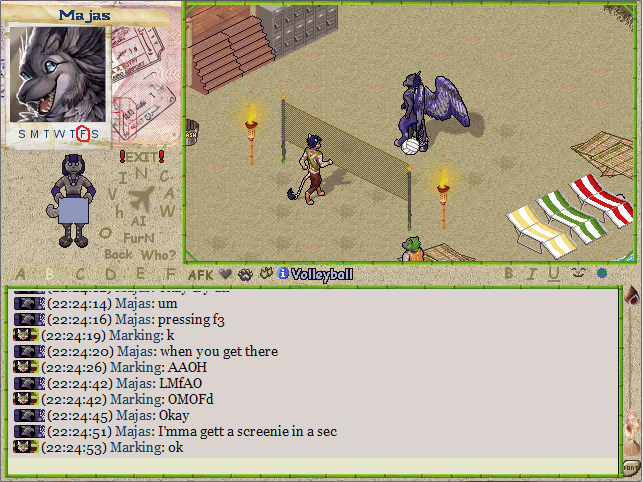
Furcadia. Credit: Majas
Furcadia personalities like Majas and Emerald Flame hit the pavement, countering accusations of financial foul play with counter-claims that the team is small and, in general, volunteer. Furcadia’s development team is mostly volunteers; its lead programmer, Treeki, a college student. Scrappiness had always been a Furcadia virtue. An extra $US250,000 ($325,185) didn’t change that. Dr. Cat, who developed Furcadia from scratch, was the most defensive:
“We’re an indie developer and not a AAA developer. This is true, and has always been true. Furcadia was originally made by two people (me and Talzhemir [‘Manda]) in one year with a budget of $US50,000 ($65,037). MMORPGs from the AAA world are made with dozens (or hundreds) of people and tens of millions of dollars.
I guess it’s flattering that there’d even be a question about whether we’re triple-A or not — we’ve done more than most small indie developers could with a small number of people and a small amount of money. . . We stretch $US250,000 ($325,185) to cover a lot more development than a AAA shop would do,” he said.
When we spoke, Dr. Cat asked me not to inquire about the delays for Furcadia features. Later, when pressed, he reiterated to me that he thinks “People’s expectations for games in general are often set by AAA games & companies.”
Echoing his views, Furcadia’s design director, Gar, explained on a forum that it can cost $US10,000 ($13,007) to “seat” a developer for a month, citing funds used for pay, equipment and software licenses. “If the Second Dreaming had a team of 6 the full Kickstarter funds should have lasted about 2 months of full development … we’ve managed 2.5 years of sustained development,” he said.
Furcadia’s scrappiness and democratic ideals are why most furres I met whiled away their entire childhoods in the furry MMO. It’s a rare world in which the user-developer barrier is thinned to nothing, in which monetisation would be an affront to its virtues. Ten years ago, I stumbled upon Furcadia in a feverish quest to test out every virtual world imaginable, and can say with confidence, that, after ten years, it has only grown to be more of itself. No amount of bells, whistles or chew toys will change that.
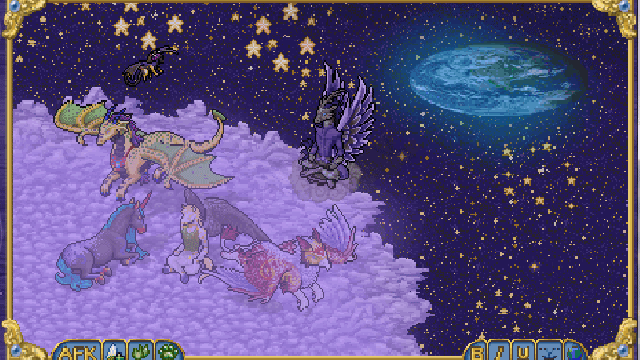
Comments